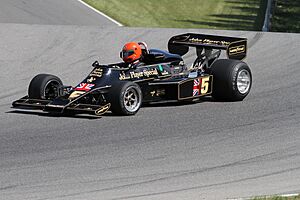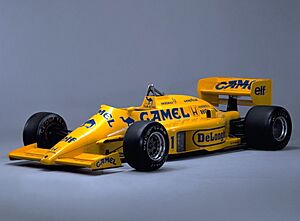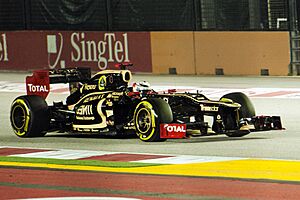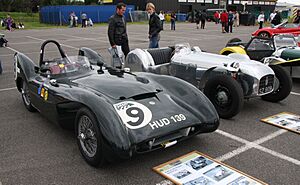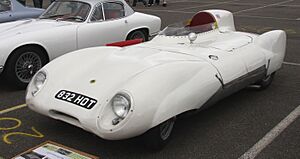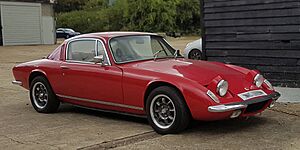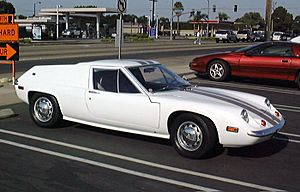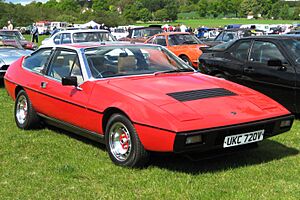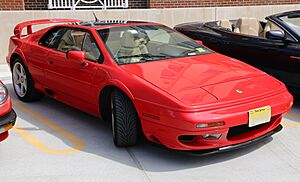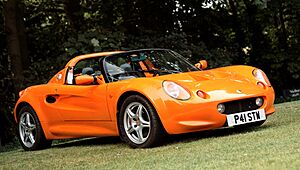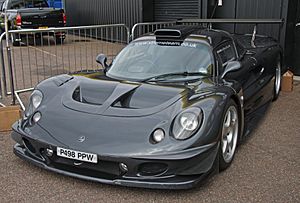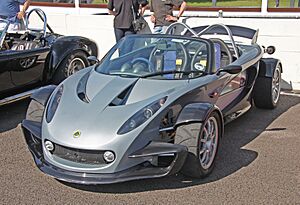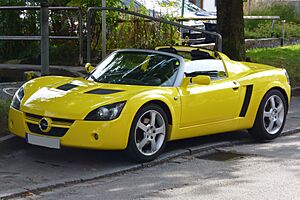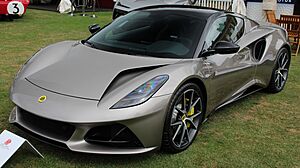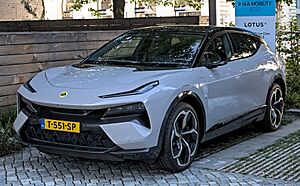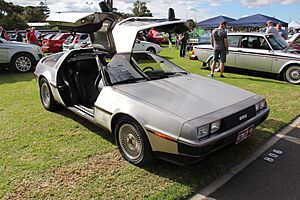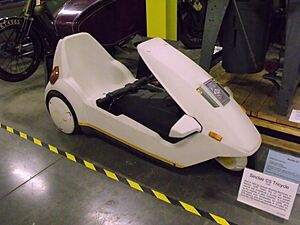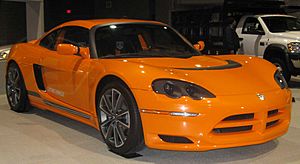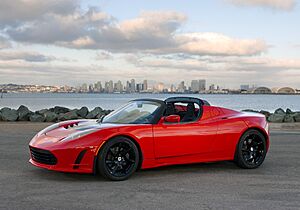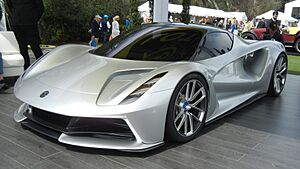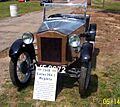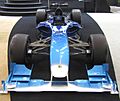Lotus Cars facts for kids
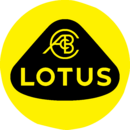
Lotus logo (2019)
|
|
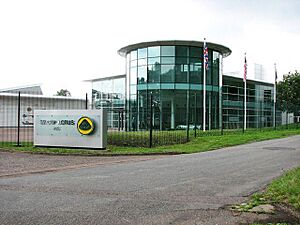 |
|
| Subsidiary | |
| Industry | Automotive |
| Founded | 1952 |
| Founder | Colin Chapman |
| Headquarters | , |
|
Area served
|
Worldwide |
|
Key people
|
|
| Products | Automobiles |
|
Production output
|
|
| Revenue | |
|
Number of employees
|
1,385 (2021) |
| Parent | Geely Holding (51%) Etika Automotive (49%) |
Lotus Group, also known as Lotus Cars, is a British company that makes fancy sports cars and electric vehicles. It's famous for building lightweight cars that are great to drive.
The Lotus Group has three main parts:
- Lotus Cars makes high-performance sports cars. Its main home is in Hethel, Norfolk, England.
- Lotus Technology Inc. focuses on all-electric cars. It's based in Wuhan, China, with offices in the UK, Netherlands, and Germany.
- Lotus Engineering is a company that helps other car makers with their engineering and design. It's located at the University of Warwick in England.
Lotus was started by Colin Chapman in 1952. Over the years, it has been owned by different companies, including General Motors and Proton. Today, the Chinese company Geely owns most of Lotus. Lotus has also been very successful in Formula One racing, winning the World Championship seven times. Some famous Lotus cars include the Lotus Seven, Elan, Esprit, and Elise.
Contents
History of Lotus
How Lotus Started
Lotus Engineering Ltd. began in 1952. However, its story actually started earlier in 1948 when Colin Chapman built his first car in a garage. The four letters in the middle of the Lotus logo stand for Chapman's full name: Anthony Colin Bruce Chapman.
The first Lotus factory was in old stables in North London. In 1954, Team Lotus was created separately from Lotus Engineering. This team raced in Formula One from 1958 to 1994. In 1959, the Lotus Group of Companies was formed. It included Lotus Cars Limited, which made road cars, and Lotus Components Limited, which made race cars for customers.
Lotus moved to a new factory in Cheshunt in 1959. Since 1966, it has been at a modern factory and test track in Hethel, Norfolk. This site used to be an airfield during World War II. The test track uses parts of the old runways.
In its early days, Lotus sold cars to people who wanted to race them. You could even buy some early road cars as kits to build yourself. This helped save money on taxes. The kit car era ended in the late 1960s and early 1970s. Later models, like the Lotus Elan Plus Two and the Lotus Eclat and Lotus Elite from the mid-1970s, were only sold already built.
Famous Early Cars
After the Lotus Elite in the 1950s, Lotus became very popular in the 1960s with the Lotus Elan. This two-seater car was later made into a four-seater version called the Elan +2S. Lotus was known for using lightweight fibreglass bodies, strong backbone frames, and special engines. These engines first came from Coventry Climax, but later used Ford parts with Lotus-designed cylinder heads. Lotus also worked with Ford on the Lotus Cortina, a successful sports car.
Another well-known Lotus car from the late 1960s and early 1970s was the two-seater Lotus Europa. This car had a lightweight body and a mid-mounted Renault engine. Later, it got the same Lotus-Ford engine used in the Elan.
The Lotus Seven, a simple, lightweight open two-seater, was made from the 1950s into the early 1970s. Lotus later sold the rights to make the Seven to Caterham, which still makes the car today.
By the mid-1970s, Lotus wanted to make more luxurious cars. They launched the Elite and Eclat models, which were four-seaters with features like air conditioning. The mid-engine car line continued with the Lotus Esprit. This car became one of Lotus's most famous models and was produced for a long time. Lotus also developed its own powerful engines, including four-cylinder and V8 engines, with turbocharged versions appearing in the Esprit.
Lotus engines were also used in other cars, like the Jensen Healey sports car. In the 1980s, Lotus worked with Vauxhall Motors to create the Lotus Carlton, which was the fastest road car Vauxhall had ever made.
Changes in Ownership
By 1980, Lotus Group faced serious money problems. Car production dropped a lot. This was due to a worldwide economic slowdown and fewer sales in the American market.
In 1982, Lotus made a deal with Toyota to share ideas and skills. Because of this, Lotus Engineering helped develop the Mk2 Toyota Supra. This partnership also allowed Lotus to launch the new Lotus Excel. Using parts from Toyota helped Lotus sell the Excel for less money than the older Eclat.
Sadly, Colin Chapman passed away in December 1982. After his death, Lotus faced financial and legal challenges. The company was almost bankrupt in 1983. David Wickins, who founded British Car Auctions, became the new chairman. He helped turn the company around by negotiating with tax authorities and finding new investors.
In 1986, General Motors bought most of Lotus. Then, in 1993, GM sold Lotus to A.C.B.N. Holdings S.A., a company owned by Italian businessman Romano Artioli. In 1996, the Malaysian car company Proton bought a majority share in Lotus.
Lotus Cars received the Queen's Award for Enterprise in 2002 for its success in international trade. Lotus cars proudly wore this award badge for several years.
On May 24, 2017, the Chinese company Geely announced it was taking a 51% ownership stake in Lotus. The remaining 49% was bought by Etika Automotive.
In January 2021, Geely announced a partnership with Renault–Nissan–Mitsubishi Alliance to develop electric performance cars. In April 2021, Lotus shared plans to make only electric cars by 2028. They also planned to increase production from about 1,500 cars per year to tens of thousands. Geely and Etika Automotive provided a lot of money to make these changes happen.
Lotus Technology Inc., the electric-vehicle part of Lotus, became a public company on Nasdaq in February 2024.
How Lotus Works Today
Today, Lotus Group Limited is divided into Lotus Cars and Lotus Engineering.
Besides making sports cars, Lotus also works as an engineering helper for other car companies. They are especially good at designing car suspensions. Lotus's engine department has designed and developed engines for many GM cars, like Vauxhall, Opel, Saab, Chevrolet, and Saturn. Some Lotus models, like the American Elise and Exige, used engines from Toyota.
Michael Kimberley, who was important at Lotus in the 1970s, returned as CEO in 2006. He helped lead the company. After him, Dany Bahar became CEO in 2009. He wanted to make Lotus a luxury brand. However, he was suspended in 2012, and his big plans for new models were cancelled. Jean Marc Gales became CEO in 2014 and helped Lotus make a profit for the first time in many years. In 2018, Feng Qingfeng from Geely took over Group Lotus.
In January 2021, Matt Windle became the managing director of Lotus Cars. In June 2025, Lotus was thinking about moving some car production from the UK to a new plant in the US. This was because of high US taxes on imported cars.
Lotus in Racing
In its early days, Lotus encouraged its customers to race their cars. The company first entered Formula One through its sister company Team Lotus in 1958. A Lotus Formula One car, driven by Stirling Moss, won its first Grand Prix race in 1960 in Monaco.
Big success came in 1963 with the Lotus 25. With Jim Clark driving, Team Lotus won its first F1 World Constructors' Championship. Clark sadly died in 1968 during a race. His death was a big loss for the team and for Formula One. That year's championship was won by Clark's teammate Graham Hill.
Team Lotus was known for making the mid-engine design popular for IndyCars. They also created the first single-piece Formula One chassis and made the engine and gearbox part of the car's structure. Team Lotus was one of the first in Formula One to add wings and shape the car's underside to create downforce (which pushes the car down for better grip). They also invented active suspension and were the first to move radiators to the sides of the car to make it more aerodynamic.
Formula One Drivers' Championship winners for Lotus include Jim Clark (1963, 1965), Graham Hill (1968), Jochen Rindt (1970), Emerson Fittipaldi (1972), and Mario Andretti (1978). In 1973, Lotus won the constructors' championship, but the drivers' title went to Jackie Stewart from Tyrrell. Lotus was the first car maker to win 50 Grand Prix races, even beating Ferrari.
Team Lotus remained a major player in Formula One until the late 1980s. Ayrton Senna drove for the team from 1985 to 1987, winning several races.
Team Lotus created Classic Team Lotus in 1992. This group still takes care of old Lotus F1 cars and races them in historic events. It also keeps the Team Lotus records and car collection, managed by Colin Chapman's son, Clive.
Team Lotus stopped racing in Formula One after the 1994 season because their cars were no longer competitive. The team won a total of 79 Grand Prix races.
The Lotus name returned to Formula One for the 2010 season with a new Malaysian team called Lotus Racing. This team used the Lotus name with permission from Group Lotus. However, Group Lotus later ended this agreement. After some legal discussions, the new team changed its name to Caterham F1 Team in 2012. Group Lotus then partnered with the Renault F1 team, which became the Lotus F1 Team and raced with Lotus-badged cars.
Group Lotus also participated in other types of motorsport, like the IndyCar Series and GP2 Series.
Lotus Car Models
Current Models
Here are some of the Lotus models you can buy today:
- Lotus Evija: This is a very special electric sports car. Only 130 of them are being made. It's Lotus's first electric car. The Evija has four electric motors, one for each wheel, making it super powerful. It can go from 0 to 100 km/h (62 mph) in under 3 seconds! Deliveries started in early 2023.
- Lotus Emira: This car was shown in July 2021, and production began in March 2022. The Emira is important because it's the last Lotus car that will use a traditional internal combustion engine.
- Lotus Eletre: This is Lotus's first electric SUV. It has a large battery and can charge very quickly. The 2024 model offers a lot of horsepower and a top speed of 260 km/h (162 mph). It's also the first Lotus to have advanced features like lidar (which helps with self-driving technology). Deliveries began in March 2023.
- Lotus Emeya: This is a battery-electric grand tourer, which means it's a fast, luxurious car designed for long journeys.
Past Models
Lotus has made many different cars over the years, including:
- Lotus Mark I (1948): A sports car based on the Austin 7.
- Lotus Seven (1957–1972): A simple, open sports car.
- Lotus 14 (1957–1963): The first production road car from Lotus.
- Lotus 26 (1962–1971): A popular sports car.
- Lotus 46 (1966–1968): A mid-engined car.
- Lotus 79 (1975–1980): A famous sports GT car.
- Lotus Elan (Type M100) (1989–1995): A front-wheel-drive convertible.
- Lotus 111 (1996–2022): The well-known Lotus Elise.
- Lotus 123 (2010–2022): A modern sports car.
Future Car Announcements
At the 2010 Paris Motorshow, Lotus announced plans for five new models. However, due to money problems, most of these plans were cancelled.
In July 2019, Lotus showed off the Evija, a powerful electric supercar.
In January 2021, Lotus announced that the Elise, Exige, and Evora would stop being made. They would be replaced by a new model, which was later revealed in July 2021 as the Emira.
In November 2021, Lotus hinted at a future SUV, which was later named the Eletre.
In September 2023, Lotus announced the Emeya, their first electric GT car.
The Lotus Theory 1 is a sports car concept that was revealed in September 2024.
Lotus Engineering
Lotus Engineering Limited is a separate part of Lotus Cars. It offers engineering help to other companies, mostly in the car industry. Besides its main office in Hethel, UK, Lotus Engineering also has centers in Ann Arbor, USA, Kuala Lumpur, Malaysia, and Shanghai, China.
Engineering Projects
Lotus Engineering has worked on many different projects for other companies, including:
- The DMC DeLorean car: Lotus helped redesign its chassis.
- The Vauxhall Lotus Carlton: This was one of the fastest saloon cars in the early 1990s.
- The 1991 Dodge Spirit R/T: Lotus designed a special engine head for this car.
- The Vauxhall VX220 (also called Opel Speedster): Lotus built this car using the same lightweight aluminum chassis as the Lotus Elise.
- The Tesla Roadster: Lotus helped design and engineer this electric sports car and built it at their factory.
- The Aston Martin DB9's chassis was developed with help from Lotus Engineering.
- Lotus was responsible for much of the design and testing of the powerful LT5 engine for the Chevrolet Corvette C4 ZR-1.
- Lotus designed and tested the GM Ecotec engine, which is used in many cars.
- Lotus helped with the Sinclair C5 electric tricycle.
- Lotus helped tune the suspension of cars like the Toyota MR2 Mk. I, Toyota Supra Mk. II and Mk. III, Isuzu Piazza, and newer Proton models.
- Lotus worked on the suspension of the Mahindra Scorpio to make it more stable.
- Lotus helped with the suspension and handling of the Volvo 480 and Nissan GT-R.
- The Dodge EV concept electric car is based on a Lotus Europa S.
- Lotus rebuilt and tuned a Lada Riva on the TV show Top Gear.
- The 2006 Volkswagen GX3 had a chassis developed by Lotus.
- The 2009 Kia Soul (UK only) had Lotus-tuned suspension.
- In 2010, Lotus provided an engine for a hybrid XJ series car.
- Lotus partnered with Jaguar to develop the chassis and engine management for the Jaguar C-X75.
- Lotus helped with the handling and steering of the 2015 Hyundai Genesis.
- The Spyker B6 Venator uses a Lotus-built engine.
- The Baojun 730, a Chinese minivan, has Lotus-tuned suspension.
- HB.T, a special track bicycle, was made with Lotus's help.
Cars Based on Lotus Designs
Some cars from other companies are based on Lotus designs:
- Detroit Electric SP.01, based on the Elise chassis.
- Hennessey Venom GT, based on the Exige/Elise chassis.
- Infiniti Emerg-e concept car, based on the Evora 414E.
- Melkus RS2000, based on the Elise chassis.
- Rinspeed sQuba concept car, based on the Elise chassis.
- Tesla Roadster, based on the Elise chassis.
- Vauxhall VX220/Opel Speedster, based on the Elise.
Electric Vehicles
Lotus Evija
Lotus showed their first electric hypercar, the Evija, in July 2019. Only 130 units are being made. Production started in summer 2020, and cars were delivered to customers in early 2023. The Evija has a powerful battery and four electric motors, one on each wheel. This gives it a total output of over 2,000 horsepower! The Evija can travel about 346 km (215 miles) on a single charge.
Other Electric Projects
The Tesla Roadster uses the Elise chassis. In 2005, Tesla and Lotus agreed that Lotus would help design and develop the Roadster and produce some of its parts.
Lotus Engineering has a special team that works on hybrid and electric vehicles. They developed the Evora 414E as their first hybrid concept car. This car could travel more than 300 miles using its hybrid system.
Lotus also joined other companies on a project called "Limo-Green." This project, funded by the UK Government, aimed to create a luxury hybrid executive car. Lotus provided the special engine for a prototype XJ series hybrid car.
Images for kids
See also
 In Spanish: Lotus Cars para niños
In Spanish: Lotus Cars para niños



